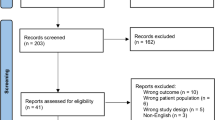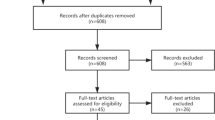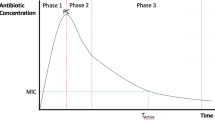Abstract
Purpose
Despite multimodal pain management and advances in anesthetic techniques, total knee arthroplasty (TKA) remains painful during the early postoperative phase. This trial investigated whether computer-assisted cryotherapy (CAC) is effective in reduction of pain and consumption of opioids in patients operated for TKA following an outpatient surgery pathway.
Methods
Sixty patients scheduled for primary TKA were included in this prospective, double-blind, randomized controlled trial receiving CAC at 10–12 °C (Cold-group, n = 30) or at 21 °C (Warm-group, n = 30) during the first 7 days after TKA according to a fixed schedule. All patients received the same pre-, peri- and postoperative care with a multimodal pain protocol. Pain was assessed before and after every session of cryotherapy using the numerical rating scale for pain (NRS-pain). The consumption of opioids was strictly noted during the first 4 postoperative days. Secondary outcomes were knee swelling, visual hematoma and patient reported outcome measures (PROMs). These parameters were measured pre-, 1, 2 and 6 weeks postoperatively.
Results
In both study groups, a reduction in NRS-pain after every CAC session were seen during the postoperative period of 7 days. A mean reduction of 0.9 and 0.7 on the NRS-pain was seen for respectively the Cold- (P = 0.008) and Warm-group (n.s.). A significant (P = 0.001) lower number of opioids were used by the Cold-group during the acute postoperative phase of 4 days, 47 and 83 tablets for respectively the Cold and Warm-group. No difference could be observed for secondary outcomes and adverse effects between both study groups.
Conclusions
Postoperative CAC can be in added value in patients following an outpatient surgery pathway for TKA, resulting in reduced experienced pain and consumption of opioids during the first postoperative days.


Similar content being viewed by others
References
Adie S, Kwan A, Naylor JM, Harris IA, Mittal R (2012) Cryotherapy following total knee replacement. Cochrane Database Syst Rev 12:9
Adie S, Naylor JM, Harris IA (2010) Cryotherapy after total knee arthroplasty: a systematic review and meta-analysis of randomized controlled trials. J Arthroplasty 25(5):709–715
Algafly AA, George KP (2007) The effect of cryotherapy on nerve conduction velocity, pain threshold and pain tolerance. Br J Sports Med 41:365–369
Barry S, Wallace L, Lamb S (2003) Cryotherapy after total knee replacement: a survey of current practice. Physiother Res Int 8:111–120
Bolton JE, Wilkinson RC (1998) Responsiveness of pain scales: a comparison of three pain intensity measures in chiropractic patients. J Manip Physiol Ther 21(1):1–7
Brooks R (1996) EuroQol: the current state of play. Health Policy 37(1):53–72
Chesterton LS, Foster NE, Ross L (2002) Skin temperature response to cryotherapy. Arch Phys Md Rehabil 83(4):543–549
DeSouza CM. Legedza AT, Sankoh AJ (2009) An overview of practical approaches for handling missing data in clinical trials. J Biopharm Stat 19(6):1055–1073
Duellman TJ, Gaffigan C, Milbrandt JC, Allan DG (2009) Multi-modal, pre-emptive analgesia decreases the length of hospital stay following total joint arthroplasty. Orthopedics 32(3):167
Dundon JM, Rymer MC, Johnson RM (2013) Total patellar skin loss from cryotherapy after total knee arthroplasty. J Arthrosplasty 25(2):376
Farrar JT, Portenoy RK, Berlin JA et al (2000) Defining the clinically important difference in pain outcome measures. Pain 88(3):287–294
Farrar JT, Young JP Jr, LaMoreaux L et al (2001) Clinical importance of changes in chronic pain intensity measured on an 11-point numerical pain rating scale. Pain 94(2):149–158
Haefeli M, Elfering A (2006) Pain assessment. Eur Spine J 15(Suppl 1):S17–S24
Hamilton TW, Strickland LH, Pandit HG (2016) A meta-analysis on the use of gabapentinoids for the treatment of acute postoperative pain following total knee arthroplasty. J Bone Joint Surg Am 98(16):1340–1350
Han C, Kuang MJ, Ma JX, Ma XL (2017) Is pregabalin effective and safe in total knee arthroplasty? A PRISMA-compliant meta-analysis of randomized-controlled trials. Medicine (Baltimore) 96(26):e6947
Haverkamp D, Breugem SJ et al (2005) Translation and validation of the Dutch version of the Oxford 12-item knee questionnaire for knee arthroplasty. Acta Orthop 76(3):347–352
Holm B, Husted H, Kehlet H, Bandholm T (2012) Effect of knee joint icing on knee extension strength and knee pain early after total knee arthroplasty: a randomized cross-over study. Clin Rehabil 26:716–723
Kort NP, Bemelmans YFL, Jansen J, vd Kuy H, Schotanus MGM (2017) Patient selection criteria for outpatient joint arthroplasty. Knee Surg Sports Traumatol Arthrosc 25(9):2668–2675
Kort NP, Bemelmans YFL, Schotanus MGM (2017) Low incidence of postoperative urinary retention with the use of a nurse-led bladder scan protocol after hip and knee arthroplasty: a retrospective cohort study. Eur J Orthop Surg Traumatol. https://doi.org/10.1007/s00590-017-2042-5
Kort NP, Bemelmans YFL, Schotanus MGM (2017) Outpatient surgery for unicompartimental knee arthroplasty is effective and safe. Knee Surg Sports Traumatol Arthrosc 25(9):2659–2667
Kullenberg B, Ylipaa S, Soderlund K, Resch S (2006) Postoperative cryotherapy after total knee arthroplasty: a prospective study of 86 patients. J Arthroplasty 21:1175–1179
Martin SS, Spindler KP, Tarter JW, Detwiler KB (2002) Does cryotherapy affect intraarticular temperature after knee arthroscopy? Clin Orthop Relat Res 400:184–189
Moher D, Hopewell S, Schulz KF et al (2010) CONSORT 2010 explanation and elaboration: updated guidelines for reporting parallel group randomised trials. BMJ 23:340–869
Roorda LD, Jones CA et al (2004) Satisfactory cross cultural equivalence of the Dutch WOMAC in patients with hip osteoarthritis waiting for arthroplasty. Ann Rheum Dis 63(1):36–42
Ruffilli A, Castagnini F, Traina F et al (2017) Temperature-controlled continuous cold flow device after total knee arthrosplasty: a randomized controlled trial study. J Knee Surg 30(7):675–681
Sadoghi P, Hasenhütl S, Gruber G et al (2018) Impact of a new cryotherapy device on early rehabilitation after primary total knee arthroplasty (TKA): a prospective randomized controlled trial. Int Orthop. https://doi.org/10.1007/s00264-018-3766-5
Saito N, Horiuchi H, Kobayashi S et al (2004) Continuous local cooling for pain relief following total hip arthroplasty. J Arthroplasty 19:334–337
Schotanus MGM, Bemelmans YFL, Grimm B, Heyligers IC, Kort NP (2017) Comparable physical activity after outpatient surgery and enhanced recovery for total knee arthroplasty. Knee Surg Sports Traumatol Arthrosc 25(11):3366–3371
Schotanus MG, Bemelmans YF, van der Kuy PH, Jansen J, Kort NP (2017) No advantage of adrenaline in the local infiltration analgesia mixture during total knee arthroplasty. Knee Surg Sports Traumatol Arthrosc 25(9):2778–2783
Sehat KR, Evans RL, Newman JH (2004) Hidden blood loss following hip and knee arthroplasty: correct management of blood loss should take hidden loss into account. J Bone Joint Surg Br 86:561–565
Su EP, Perna M, Boettner F et al (2012) A prospective, multi-center, randomised trial to evaluate the efficacy of a cryopneumatic device on total knee arthroplasty recovery. J Bone Joint Surg Br 94(11):153–156
Thienpont E (2014) Does advanced cryotherapy reduce pain and narcotic consumption after knee arthroplasty? Clin Orthop Relat Res 472(11):3417–3423
Von Korff M, Jensen MP, Karoly P (2000) Assessing global pain severity by self-report in clinical and health services research. Spine (Phila Pa 1976) 25(24):3140–3151
Funding
No financial support was received for this study.
Author information
Authors and Affiliations
Contributions
Elke Thijs: Designed the study, gathered and analyzed all the data, wrote the initial draft of the manuscript and managed the study. Martijn G.M. Schotanus: Designed the study, analyzed the data, wrote and revised the manuscript and managed the study. Yoeri F.L. Bemelmans: Gathered data, wrote and revised the manuscript. Nanne P Kort: Conceived the study and revised the manuscript.
Corresponding author
Ethics declarations
Conflict of interest
One author, Nanne Kort, is a paid consultant for Zimmer-Biomet, Europe. The other authors certify that they have no commercial associations (e.g., consultancies, stock ownership, equity interest, patent/licensing arrangements, etc.) that might pose a conflict of interest in connection with the submitted manuscript.
Ethical approval
The study was approved by the ethics committee of Zuyderland-Zuyd, Number 15-T-135 and registered online at the Dutch Trial Register (http://www.trialregister.nl, No. NTR5565).
Informed consent
For this type of study formal informed consent was obtained from each included patient.
Rights and permissions
About this article
Cite this article
Thijs, E., Schotanus, M.G.M., Bemelmans, Y.F.L. et al. Reduced opiate use after total knee arthroplasty using computer-assisted cryotherapy. Knee Surg Sports Traumatol Arthrosc 27, 1204–1212 (2019). https://doi.org/10.1007/s00167-018-4962-y
Received:
Accepted:
Published:
Issue Date:
DOI: https://doi.org/10.1007/s00167-018-4962-y




